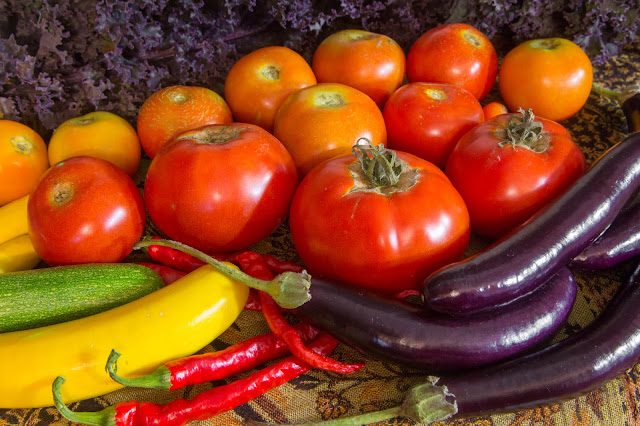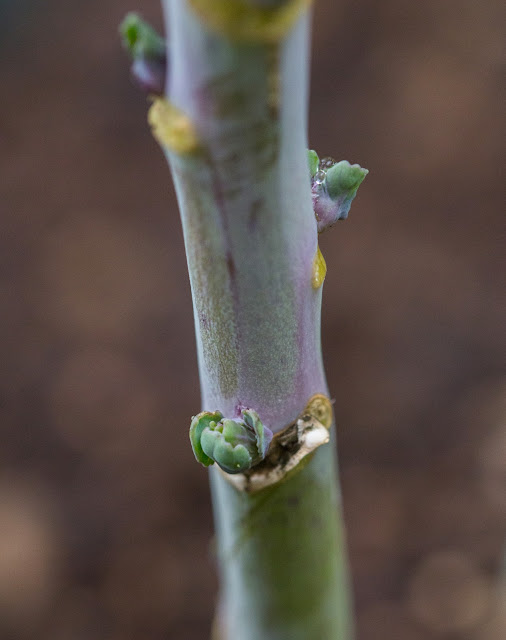Unlike other flower-based concoctions, it's neither too sickly nor bland. Interestingly, I find elderflowers themselves sometimes smell unpleasant fresh - and are very variable. But they are transformed by the cordial-making process into that perfect blend of sweet, sour, and fragrant that it so appealing.
This flower head is just about ready for picking - most of the tiny buds are open.
Here's how I make it - there are plenty of recipes available in books and online, but over the years I've found a couple of tweaks make a big difference (see below). It's really very simple, quick, and requires only one slightly unusual ingredient, citric acid, which is a really useful thing for all sorts of cordials and other homemade treats.
To make elderflower cordial
Ingredients
Elderflowers (see below for quantities, but for a bottle of cordial, at least a dozen to twenty flower heads), shaken gently to dislodge any insects; take care not to include any leaves or long sections of stem, but the tiny stems within the flowerhead are fine
Water
White or golden caster sugar
Citric acid
Method
1. Make a sugar syrup by boiling water and combining with an equal volume of sugar - i.e. if you fill a jug with sugar, add boiling water until the level is the same as the sugar. Stir until dissolved - this should take seconds. How much you make depends how much cordial you want, but 500-750ml would fill the average glass (wine or spirit) bottle. Leftover syrup can be used in cocktails or for making sorbet.
2. Once the sugar syrup has cooled (blood temperature or below is fine), combine with as many elderflowers as the container will fit without overflowing - the more the better! Note, many recipes specify a number of 'heads' (elderflowers grow in flat flowerheads as large as an outstretched hand), but these are always too few, and the resulting cordial, like shop-bought, tends to be too weak. I pick as many as will fit in a large bowl or jug, then pour over the syrup, but if you only have one container, you could put the elderflowers in first, then pour in the sugar, then the water; whichever way round you do it, make sure the flowers are packed in.
3. Leave to steep for at least 24 hours, but not so long as it begins to go mouldy or ferment (maybe 2-3 days in a cool place or the fridge).
4. Strain. For ease, I do it first through a regular sieve or even a colander, then through the same lined with kitchen paper or muslin, or a fine coffee filter. Leave to drain - this may take another 12-24 hours. Don't force it, or the cordial may become cloudy (there will be some pollen residue in the final cordial, but this will settle over time).
5. Adjust the acidity with citric acid. This is where I differ from most recipes, which call for lemon (juice and sometimes also rind) - citric acid is cleaner-tasting, producing a purer elderflower essence, adds no cloudiness, and it's easier to standardise your measurements. I prefer a fairly tart cordial, but many would like it sweeter - if you add too much, you can adjust with more sugar, up to a point. A little goes a long way, so for a bottle of cordial you may only need a half teaspoon of citric acid. But start with less - every tiny pinch can make a big difference. Incidentally, I buy this from shops with homebrew sections - in the UK try Wilkinson or Morrisons, or else you can easily order it online.
6. Bottle in clean, sterilised bottles (glass for preference, though plastic may do). Spirits bottles with cork stoppers are a good choice, although if the cordial spontaneously ferments, the corks can blow off. This is still better than the bottles exploding, which may happen with glass bottles and fixed lids. If you pasteurise the cordial, fermentation should not occur.
7. Optional: pasteurise as you would other bottled goods, e.g. by standing the bottles in a pan of simmering water, approximately 70ºC until the cordial is thoroughly heated, but take care not to boil. Glass is obviously better for this than plastic, which may not stand the heat. Alternatively, you could heat the cordial to this sort of temperature before pouring into the bottles, and then seal immediately, but this can cause a vacuum to form and may make them harder to open. I only pasteurised my cordials this year, previously paying the price in their fermenting, usually in warm weather. See storage tips below.
8. Store. Bottles will keep indefinitely in the fridge, but this can take up a lot of space. Somewhere cool and dry, like a larder, they should be fine for a few months or even a year or more. Once opened, refrigerate. If they develop mould on the surface, you can strain the cordial to remove this, and it will continue to keep well. Alternatively, the cordial can be frozen and defrosted as required (freeze in ice cube bags or trays, then bag up for ease of use). I have some bottles several years old, and they now resemble fine dessert wine - I'm not sure if they are alcoholic, probably not very, but the taste is very special at any age.
You can turn this into a liqueur by adding alcohol - something plain like vodka would work best, around 50:50. You may need to adjust the flavour accordingly - generally, liqueurs need to be stronger in flavour (i.e. more sugar and acid) to balance the alcohol. This should keep better than the plain cordial.
Elderflower cordial is delicious diluted with plain, or better sparkling water. The cordial and liqueur can both be used in cocktails, with sparkling wine, or shaken with vodka or gin for an elderflower martini, or with a spirit and mixer, e.g. gin, elderflower cordial, and sparkling water or tonic.
We have three large, self-sown elders in the garden, one of which is on the left here. The dark, cut-leaved one on the right is over the fence, but I've managed to sequester some flowers. I want some of these of my own, so I'll take cuttings soon*.
*I didn't take cuttings but I bought one for an ornamental border on the other side of the garden.
I wrote this two years ago, but I wanted some more photos so it had to wait until elderflower season came round again, but then by the time I'd completed it it was a bit late, so here I am posting it in 2019 at last!































